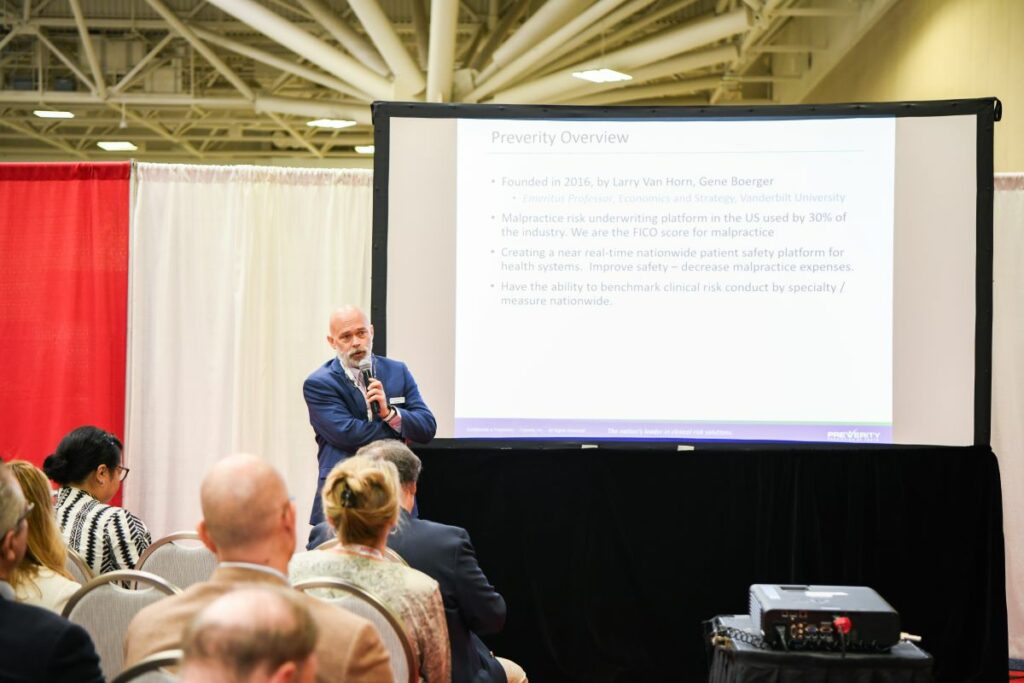Three Big Takeaways from ASHRM's 2023 Conference
November 16, 2023
There’s growing interest in clinical data that can pinpoint risk and enhance patient safety.
I recently participated in the annual American Society for Health Care Risk Management conference with Larry Van Horn, Preverity’s CEO and Founder. The risk managers who participate in ASHRM are some of the best-informed risk professionals in the field, and the conference exceeded our expectations, with forward-looking speakers and an engaged audience.
As the healthcare industry evolves and new challenges arise, hospital risk managers increasingly look for innovative ways to make patient safety achievable and measurable. Larry’s presentation on clinical activity data drew a standing-room-only audience keen to learn more.
As I reflect on what I heard, three big ideas stood out this year.
1. Since most hospital systems “self-insure,” retaining medical liability risk, hospital risk managers share similar concerns to malpractice insurers and reinsurers. What’s new is the emerging data that helps both sides to identify risk before it happens.
2. Hospital risk managers are looking for innovative ways to ensure patient safety. But they must also engage physicians in this effort—the earlier, the better. When physicians can access clinical data that benchmark their activity to their peers, they’re more likely to adopt safer practices.
3. Risk managers understand data analytics’ potential and are keenly interested in using clinical activity data to identify and prevent risky practices. When healthcare professionals are shown data that explains avoidable risks, they are more likely to embrace change.
How do these three big ideas translate for busy risk managers?
Based on what I heard, here are thoughts on new approaches to risk management.
First, as I talk to people committed to reducing healthcare risk, it’s clear that hospital risk managers and medical liability re/insurers share many of the same concerns about reducing exposures and improving patient safety. What’s changing is how both sides leverage emerging data to pinpoint risky activity that disproportionately triggers liability claims. Both sides see the value of new data, technology and well-documented protocols to reduce risk and associated malpractice claims.
However, risk managers and physicians don’t always see eye to eye. Risk managers and physicians have very different training and professional experience; doctors sometimes see healthcare risk managers as adversaries, and a negative stigma remains associated with the role.
At Preverity, we see how clinical data can bridge the gap. Our fact-based approach makes it easier for healthcare providers to understand how their actions align with proactive risk assessment and mitigation.
Second, as the healthcare industry evolves and new challenges arise, hospital risk managers increasingly seek ways to prioritize patient safety. I learned more about two innovative practices: simulation training and patient portal access.
- Simulation training recreates realistic clinical scenarios that teach medical staff how to respond to emergencies or complex procedures. This innovative training can reduce medical errors, improve communication and teamwork, and increase confidence and competence among healthcare providers. Interesting stuff.
- Secure patient portals increasingly allow patients to access medical records, communicate with their care team, and manage their health conditions. Patient portals promote transparency, engagement, and shared decision-making, improving patient satisfaction and reducing the risk of miscommunication and misunderstanding.
Third, there’s keen interest in using clinical activity data to identify, address, and evaluate risky practices. Clinical activity data is a comprehensive and timely source of information about the patient care delivered by healthcare providers. This data includes electronic medical records, billing and claims, prescription tracking, lab results, and patient surveys.

In his presentation, Larry emphasized the importance of analyzing clinical activity data to uncover unsafe practices and improvement areas. Risk managers can use advanced analytics and benchmarking tools to identify discrepancies and develop targeted interventions by comparing their data with national and regional benchmarks. Risk managers and physicians see how their actions compare to their peers by reviewing the data dashboard together; this leads to more productive discussion.
Larry also pointed out that clinical activity data can help predict and prevent adverse events by monitoring high-risk activity and reducing the likelihood of harm. For example, Preverity can detect patterns of risky behavior, such as excessive use of opioids, delays in diagnostic tests, or poor communication between care providers.
Benchmarking clinical data as recent as 90 days ago yields timely insights that inform frontline healthcare providers and risk managers. Furthermore, it allows hospitals to measure their risk performance against similar regional hospitals, identify areas for improvement, and take proactive steps to address concerning trends.
Perhaps the most significant benefit of using clinical data for safety is that it doesn’t necessitate large investments in technology or the potential for future incompatibility, e.g., “technical debt.” Instead, risk managers can utilize existing data streams and analytics tools to gather these insights, delivering a quick and cost-effective solution for enhancing patient safety.
By leveraging clinical activity data, medical staff can learn better approaches, risk managers can detect and prevent risks, and patients benefit directly from safer practices. Everyone’s objective should be to create a culture of safety and risk mitigation that supports excellence in healthcare delivery.
We’re passionate about detecting clinical risk, and the positive response to Preverity’s session on clinical activity data tells me we’re on to something big. Contact me directly if you’d like to learn more about how Preverity’s data insights address the risks you face daily.
Enjoy a few captured ASHRM moments:





